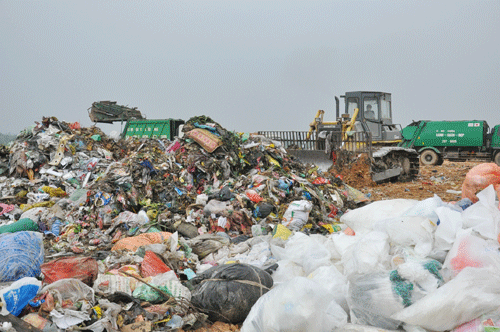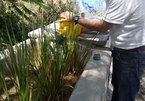The locals living near the Nam Son landfill in Soc Son district some days ago tried to prevent garbage-carrying trucks from entering the landfill. This was the seventh gathering of locals over the last three years.

Hanoi authorities have been warned that more public gatherings will be seen until the problems with Nam Son landfill can be settled.
Under the solid waste management plan by 2020, the Nam Son Waste Treatment Complex receives and treats 4,500 tons of domestic waste a day, while the Xuan Son Complex treats 700 tons.
| The locals living near the Nam Son landfill in Soc Son district some days ago tried to prevent garbage-carrying trucks from entering the landfill. This was the seventh gathering of locals over the last three years. |
However, both landfills have become overloaded. Nam Son has to receive 5,000 tons a day, while Xuan Son had 1,200 tons
In order to treat the increasingly high volume of domestic waste, Hanoi has put some waste treatment plants into operation, including Nedo incineration plant (75 tons a day), belonging to Nam Son Complex, and Son Tay (700 tons a day), Xuan Son (150 tons), Phuong Dinh – Dan Phuong (200 tons).
However, some plants have been operating ineffectively because of inadequate technologies and degraded equipment. The plants often have to stop operation for maintenance.
Anticipating the overloading of the waste treatment complexes, Hanoi has repeatedly called for private investment in waste treatment projects.
Five new projects have been licensed, including two projects in Dong Ke (Chuong My district) and Phu Dong (Gia Lam district); the Soc Son waste-to-electricity plant (belonging to Nam Son Complex), Xuan Son waste-to-electricity, and a project on gasifying waste to generate electricity.
However, the projects have been going very slowly and it is possible they won’t be operational by 2021 as initially planned.
Domestic garbage is not the only problem of Hanoi. It also has to treat 150,000 cubic meters of leachate from untreated dumping grounds.
This was also why local people gathered to prevent garbage trucks from entering Nam Son Waste Treatment Complex. Prior to that, Phu Dien – SFC stopped the operation of the leachate treatment station at Nam Son Complex, which had spread bad odor to residential quarters nearby.
According to Hoang Duong Tung, former Deputy General Director of the Directorate General of Environment, a cubic meter of buried waste will produce 1.3 cubic meters of leachate.
Meanwhile, 85-90 percent of landfills in Hanoi are unsanitary.
Hanoi’s Mayor Nguyen Duc Chung told the press that municipal authorities have asked the government to urgently settle the leachate problem.
He has also urged the implementation of the Nam Son Waste-to-Electricity Plant with capacity of 4,000 tons a day. However, even when the plant becomes operational, Hanoi will still have to bury 5 percent of waste.
Thanh Lich

Vietnamese Govt considers fee for domestic waste treatment by volume
If the draft law is approved, people will pay a waste collection and treatment fee based on the amount of waste they produce.

Da Nang pilots vetiver grass waste treatment system
A group of scientists and biological researchers from Da Nang’s Teacher Training and Engineering College has developed a vetiver (Vetiveria Zizanioides) grass-based system to treat leaks at Khanh Son dump in the city.
 Landfills in Hanoi have become overloaded as progress on waste treatment projects continues slowly.
Landfills in Hanoi have become overloaded as progress on waste treatment projects continues slowly.